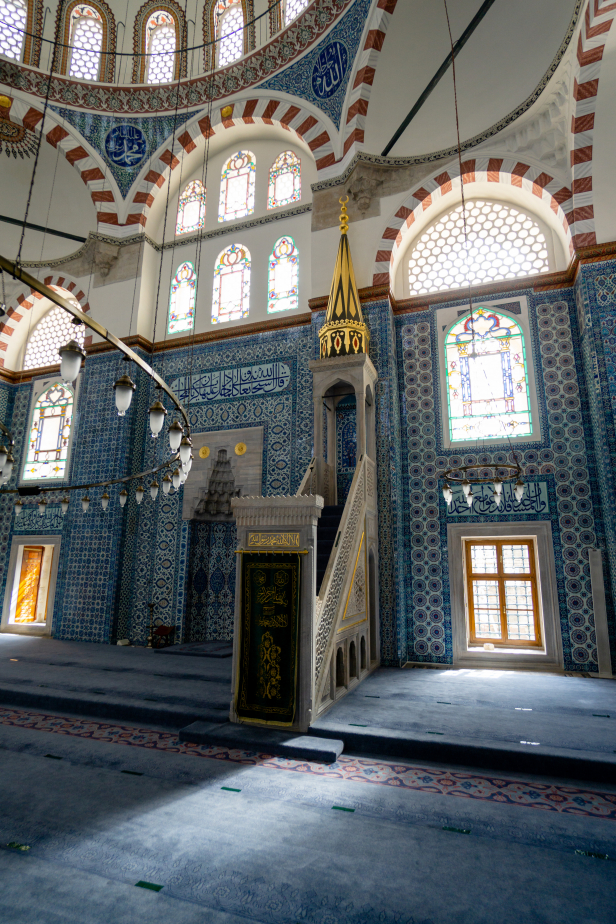Rüstem Paşa Mosque
(Rüstem Paşa Camii)
/ By Josh
Cost: Free
Great for: Mimar Sinan, Iznik Tiles, Ottoman Architecture, Shopping
Designed by the most celebrated Ottoman architect for a powerful grand vizier married to the favorite daughter of the Empire’s most powerful Sultans, the Rüstem Paşa mosque is one of Istanbul’s most overlooked sights. Built in the midst of Istanbul’s ancient trading district, Rüstem Paşa Mosque sits above the maze of narrow crooked streets lined with warehouses and shops that date back to the Roman and Byzantine periods, and while this is one of the most touristic parts of Istanbul, this fine Ottoman monument remains a hidden sanctuary surrounded by a sea of chaos.
Why Visit?
Commissioned in 1650 by Rüstem Paşa, grand vizier under Sultan Suleyman the Magnificent, Rüstem Paşa Mosque was built in a rather unusual location. The Tahtakale neighbourhood is much as it was 500 years ago: a mass of ancient trade houses crowded closely together with a a flow of goods, merchants, and craftsman taking advantage of the location near the docks. The renowned Architect Mimar Sinan (see Süleymaniye Mosque, Selimiye Mosque, and Şehzadebaşı Mosque for examples of his work) designed his mosque to stand on top of a block of shops. This allowed the mosque to stand high above the crowded streets, and likely generated revenue for the maintenance of the mosque and its charities.

Despite the odd location the architect Sinan designed this mosque with a number of his usual design features. The single-domed mosque is fronted by a fine portico of small domes and an open porch-like space that overlooks the streets below. Access to this area is through a pair of covered stairways on each side of the porch.
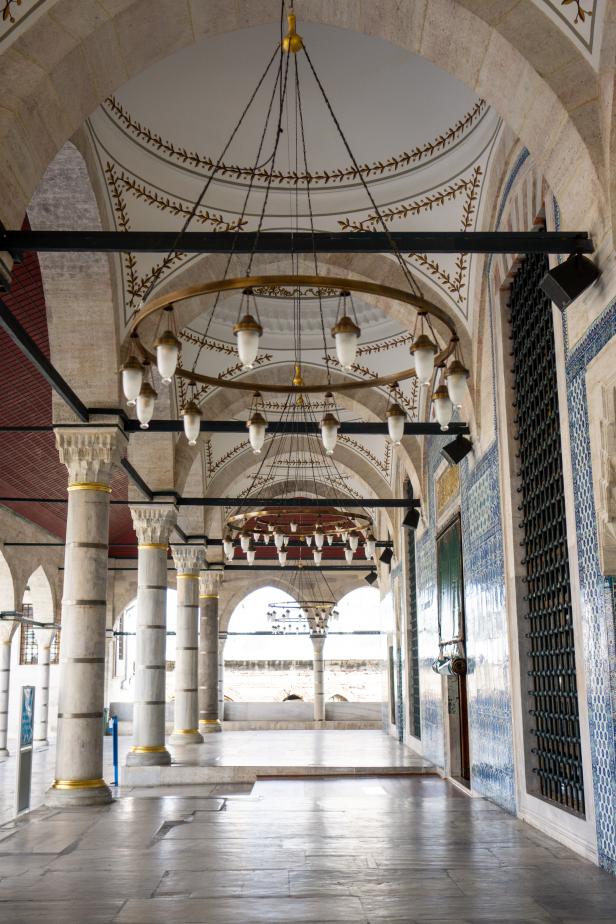
The interior of the mosque consists of a single large dome set atop four small squinches transferring the circle of the dome onto the square of the room. On either side of the central space are a pair of low aisle-like rooms open to the center. The interior of the mosque is decorated with fine İznik tile, with flowing blue and white forms accented by the red of stylized tulips and carnations. The walls, pillars, pendentives, and mihrab are all covered in the tiles; such a heavy use of tile was unusual in the works of Mimar Sinan who tended to let the architecture itself be the ornamentation with only limited painted patterns for accent. While the mosque is much smaller than Istanbul’s royal mosques, the volume of these expensive tiles make it an incredibly expensive and lavish project. (For more on Iznik tiles and the history of the art see our Guide to the Town of İznik.)
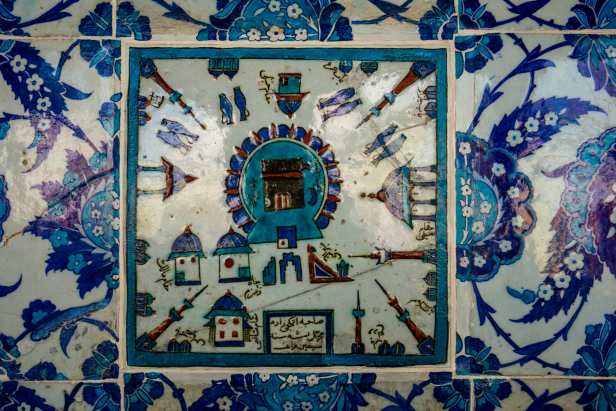
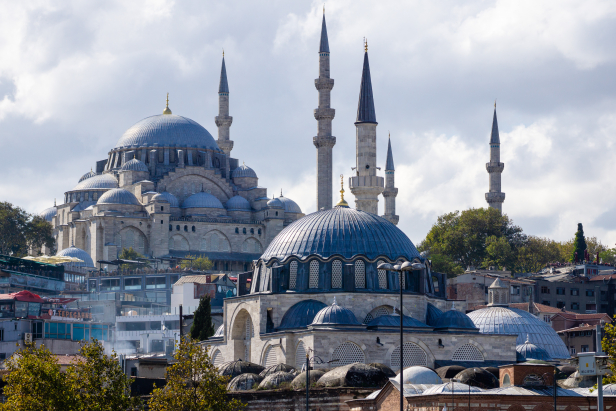
As the mosque is tall relative to its width and without the numerous supporting semidomes seen in other mosques (see Şehzadebaşı mosque) there is more exterior wall in which to put windows making Rüstem Paşa Mosque bright and airy inside.
The Şadirvan (fountain for ritual cleansing) is rather disjointed from the rest of the building and set on the lower floor in a small courtyard near the coast road.
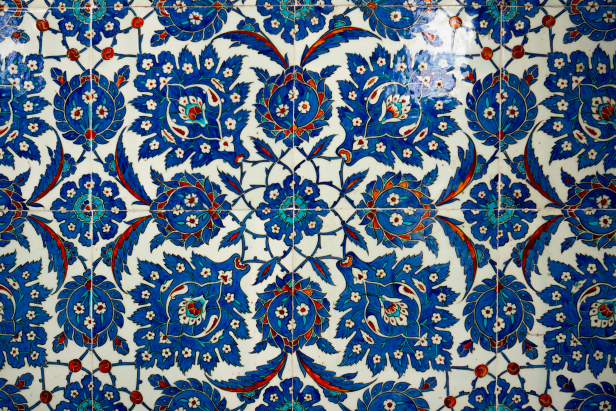
Rüstem Paşa was himself a rather interesting character and perhaps equally interesting is the relationship between Rüstem Paşa, his wife Mihrimah, and Mimar Sinan, architect of this mosque.
Rüstem Paşa was taken into the imperial machine through the devşirme system, a system in which bright young men of minority ethnicity (Greek, Armenian, Romanian, Albanian etc.) were taken and trained to serve the empire as soldiers, engineers, architects (even the architect Mimar Sinan is an example of this), as well as politicians.
Subscribe to The Art of Wayfaring
Rüstem Paşa rose through the ranks reaching the incredible height of Grand Vizier, one of the most powerful positions in what was one of the most powerful political entities of its time. As Rüstem Paşa was growing in influence he married Mihrimah, the favorite daughter of Sultan Suleyman. Among Mihrimah’s suitors however was Mimar Sinan, favored architect of the court. Sinan however was already rather old and married and so this arrangement was seen as unfavorable. Mimar Sinan would go on to build two mosques in honour of Mihrimah (Mihrimah Mosque in Üsküdar, and Mihrimah Mosque in Edirnekapı) as well as this Rüstem Paşa Mosque, built for his rival.
Grand Vizier Rüstem Paşa became entangled in the internal intrigues of the royal family. Along with his wife Mihrimah and her mother Hürrem Sultan (Roxelana, favorite wife of Sultan Suleyman the Magnificent), Rüstem Paşa is said to have schemed against heir apparent Mustafa, leading to the execution of the prince which would open opportunity for her own son Mehmet to take the throne (Mehmet would die of illness before he could take the throne and Şehzadebaşı Mosque was built for him; his tomb is in the mosque complex).
Rüstem Paşa was made a scapegoat in the plot to have the prince killed and his reputation was sullied. He died in 1561, before the completion of his namesake mosque, and was buried in a tomb next to Prince Mehmet in the complex of the above mentioned Şehzadebaşı Mosque.
How To Get There
Public Transit
Set in the midst of one of Istanbul’s oldest and most crowded neighborhoods, driving to Rüstem Paşa is not really a good option. However, Eminönü is a public transit hub with boats, busses, a tramway, and an intercontinental underwater metro all passing nearby.
For all the below modes of transport, head towards the square in front of the Egyptian Spice Market and Yeni Mosque (New Mosque). From here you will be able to see the dome of Rüstem Paşa rising above the historic markets to the West. Make your way through the narrow streets keeping an eye out for a marble staircase leading up to the mosque porch.
Ferry:
The Eminönü ferry terminal has service from the European docks of Kadıköy and Üsküdar, as well as service to less frequent routes that run up and down the Bosphorus.
Tramway:
The T1 tramline stops at Eminönü and runs by major sites such as the Hagia Sophia, The Blue Mosque, and on towards Galata.
Marmaray (Intercontinental metro line):
The closest stop from this rail line is Sirkeci and only 5 minutes away from Rüstem Paşa.
Where To Stay
In the heart of historic Istanbul the list of places to stay is far too long to include here. The neighbourhoods of Karaköy and Galata are just across the Galata bridge and are full of nice hotels in historic buildings. A little bit further through İstiklal Avenue and you will be at Gezi Park where a number of Istanbul’s new high-end hotels are located. Of course there are also dozens (possibly hundreds) of other hotels scattered throughout the Fatih district.
Other Tips
Planning on visiting Rüstem Paşa Mosque? Make sure to check the rest of our Istanbul Guides!
Subscribe to The Art of Wayfaring
Have any tips or info to add? Spot any mistakes? We’d love to hear about it.
